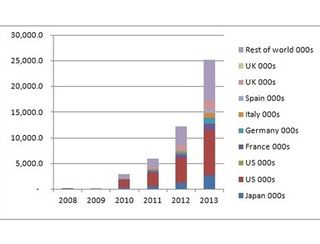Is 3D television just a great big swizz?
TechRadar uncovers the substance behind the 3D TV hype
Not all home cinema enthusiasts are entirely sold on or enthused by the idea of 3D in the lounge, with many citing reasons more to do with the social element of TV-viewing as opposed to any new forms of technical wizardry on offer.
"Although I'm not against 3D in the home per se, and am actually a fan of big screen, polarised 3D in the cinema, its adoption in a home setting will be severely hampered for a couple of reasons," argues Rik Henderson, Deputy Editor on Home Cinema Choice magazine. "Firstly, people are unlikely, on a regular basis, to watch a movie or television together with oversized, gimmicky specs on.
"They might do so on occasion, as a social activity (in much the same way that the Nintendo Wii is used as the focal point for many families), but there is far too much faff involved in the entire family donning glasses, ensuring they are sat in the optimum viewing position, and partaking in the activity for a considerable amount of time. To suggest that they'll do this more than once a week is ambitious at best.

"The second, and most important, reason is that the rapid rise in popularity of HDTVs has seen a vast amount of households in the UK invest in an expensive flatscreen TV in the last two or three years.
"Although the average life-expectancy of a TV today is no longer that of the last generation (when many sets would only be replaced after 10-15 years of service), it is unfeasible to expect the same families to re-invest again so soon after. And then replace their Blu-ray deck, too?"
Henderson also adds that there are other reasons for his reticence on 3D TV that are "medical and otherwise," (many still complain of headaches after extended hours of viewing) "but these two are fundamental sticking blocks for a new technology to overcome to make a splash in the market and with content suppliers not known for their patience (HD DVD anyone?), how long will it be before their funds and support are moved into other areas of entertainment expansion?"
Another convincing argument against mass uptake of 3D in the home is that fact that there are massive 'dimensionalisation' difficulties in making non-native content into 3D.
Get daily insight, inspiration and deals in your inbox
Sign up for breaking news, reviews, opinion, top tech deals, and more.
"Despite any claims it is very difficult to dimensionalise content properly (in the range of $10,000-100,000 per minute of real 2D footage) and the overall experience is much worse than native 3D," notes Tom Morrod, Senior Analyst and Head of TV Technology at Screen Digest.
"This was importantly not such an issue with HD so a vast library of SD content could be upconverted and it could apply to any and all content types so there was immediately a vast array of legacy content available.
"The only legacy content that can be dimensionalised is animated CG movies where the scripts can just be rendered from a second viewpoint and edited together. But no one can re-do old movies with a second camera and the technology for 'creating' the illusion of a 3rd dimension is difficult."
The CES 2010 3D hype-machine
Nvidia is pre-empting this year's CES 3D excitement by touting its latest 3D Blu-ray movie 'solution' to European press this month - a PC equipped with its own 3D Vision active-shutter glasses and new 1080p, 3D LCD displays from Acer "to showcase how consumers will experience this new 3D Blu-ray content once it is commercially available."
"2010 is poised to be the year where consumers can enjoy stunning 3D experiences across all entertainment mediums, including gaming, photographs, web browsing, and of course, movie," claims Nvidia's latest 3D release, adding how the company is "pleased to announce that the amazing 3D experience that has proven so popular in movie theaters is about to come home."
Yet while we are big fans of Nvidia's 3D Vision glasses for gaming, we remain to be sold on the idea of using your laptop or PC as your primary screen to watch movies on. We have that nice big new HDTV for that very purpose, don't you know! Plus, outside of that hardcore niche of PC gaming geeks (a group to which, we should note, we count ourselves proud to be members) proper stereoscopic 3D is still very much in it's infancy in the home.
"We have yet to see any distribution standards for stereoscopic 3D (polarised or active glasses) so there isn't actually any content to be seen yet," says Tom Morrod.

SCREEN SALES: Screen Digest's forecasted growth of worldwide 3D-capable screen sales 2008 - 2013
Standards are expected next year - starting with Sky's in-house standard and including an announcement for Blu-ray Disc (from BDA) and SMPTE, "probably the two most important standards for capture, edit and distribution," notes Morrod. The key problem here being that until these standards are set there is "no way of systematically sending content to the home, either on BD, VoD or broadcast."
Which is where games consoles look set to trump TV set-top offerings and 3D Blu-ray movies in the race to offer 3D fun in your lounge. Both the Xbox 360 and PS3 are 3D capable with firmware upgrades and they are also, as the Screed Digest analyst puts it, "independent ecosystems and games rendering in 3D is quite a simple technology too."
Current page: 3D TV in the home: the sticking points
Prev Page Is 3D TV just a massive swizz? Next Page 3D console gaming growth spurt











